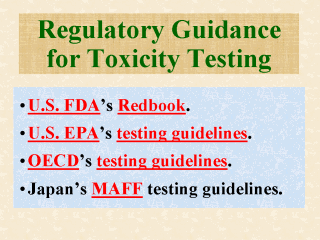| front |1 |2 |3 |4 |5 |6 |7 |8 |9 |10 |11 |12 |13 |14 |15 |16 |17 |18 |19 |20 |21 |22 |23 |24 |25 |review |
 |
The toxicity
studies required for health risk assessment were discussed briefly in the last three
slides. Guidance documents for these types of toxicologic studies have been provided by
regulatory agencies in the United States and overseas. Some of these documents can be
found at the web sites to which the key words in this slide have been hyperlinked. The guidance documents are myriad and extensive, with each generally covering such basic relevant elements as good laboratory practices, animal husbandry, selection of test animals, dose-findings, and reporting of results. Japanís guidelines are provided by its Ministry of Agriculture, Forestry and Fisheries (MAFF). As mentioned in Slide 18, this and some other documents have been highlighted in several chapters in Hayes (1994). The Redbook, not to be confused with that by National Research Council (1983), is actually the nickname for U.S. FDAís guidance document entitled ďToxicological Principles for the Safety Assessment of Direct Food Additives and Color Additives Used in Food.Ē This document provides detailed guidelines for testing the human health effects of food ingredients. Also of note here is that the Organization for Economic Cooperation and Development (OECD) has been called a think tank. It is a body with 29 advanced member countries (e.g., United States, Japan, Canada, United Kingdom, Italy, Korea, Denmark, etc.) working together to provide their governments with a setting to discuss, to develop, and to perfect their economic, social, and health policies that are deemed to be beneficial to them as a rich manís club. |